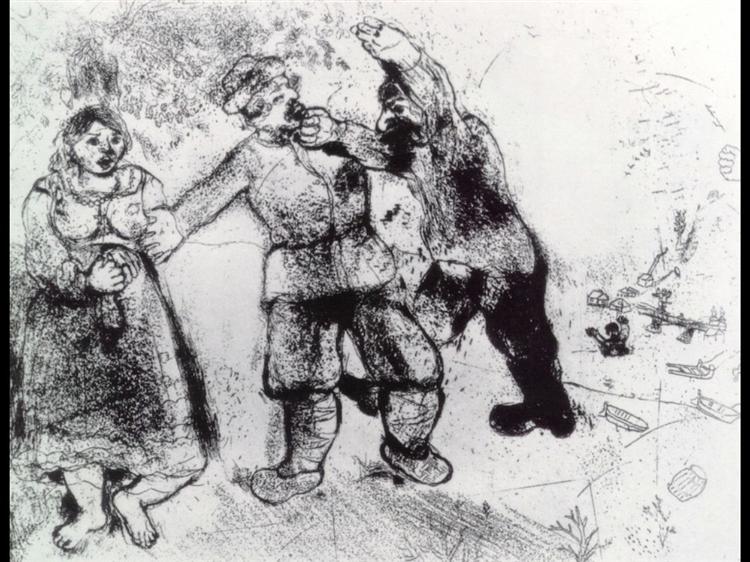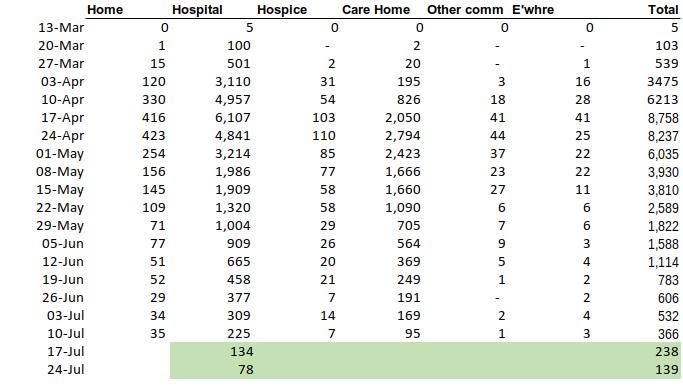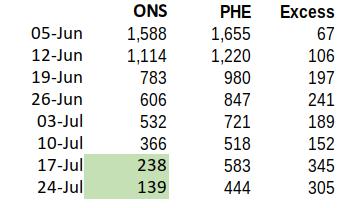by Zugzwang

The anti-hero of Gogol’s Dead Souls, Pavel Ivanovich Chichikov, had his reasons for cultivating the nobility of a provincial Russian backwater, and buying from them, for a nominal sum, those of their serfs who happened to be dead. This saved the vendors an amount of poll tax (which continued to be payable for some time after death) and transformed Chichikov himself into a gentleman proprietor of some 400 serfs, potentially capable of raising a large loan on these assets and eloping (presumably under another name) with the Governor’s daughter.
When I first read Gogol, I found the whole idea totally obscure and mystifying, and I’m not sure that he ever spells out in words of one syllable how Chichikov’s business model is supposed to work. There’s a highly respectable view that the whole thing was always intended as pure shaggy-dog, and it’s only fitting that it breaks off in mid-sentence, as an act of Shandyean surrealism.
Compared with the COVID-19 mortality statistics, however, Gogol provides us with a paradigm of lucidity. Chichikov had found a way of monetising actual serfs who merely happened to have died. We have a Government agency, Public Health England, which seems to be busy manufacturing statistical deaths, to no purpose that makes even Chichikovian sense.
The problem was uncovered a couple of weeks ago by the indefatigable Carl Heneghan. He pointed out that the daily death statistics which were being used to guide public attitudes to the progress of the UK’s epidemic bore only a loose relation to the statistics coming out of the hospitals and the ONS:

Professor Heneghan noted that the red line in the above graph (the PHE version) seemed not to be falling nearly as fast as the deaths being reported through other official channels. In the accompanying text, Heneghan speculated that PHE might be bringing forward batches of deaths that had occurred many weeks earlier. The Government took no apparent notice. Two days later, Heneghan returned to the question with the devastating observation that the PHE statistics were constructed in a way that not only precluded anyone recovering from COVID-19 having once tested positive, but also included their subsequent deaths, whether due to the virus or not (e.g. being run over by a bus). What really got Matt Hancock’s attention, and led to the immediate withdrawal of the PHE statistics from the DHSC’s daily round-up, was the observation that the PHE definition admitted the possibility that lots of Covid-positive individuals might be tactless enough to die of winter flu, or old age, just when the Second Wave was conjecturally due to arrive (e.g. care home residents), thus swelling the apparent size of the Wave.
Since July 17th, therefore, the daily death statistics have not been published directly by the Government, which is currently “investigating” them. But they do go on being input into the Government’s coronavirus dashboard, which is fed by PHE. Not only that, they continue to illustrate the official thesis that while the virus may be on its way out, it is going very, very, slowly. The rolling seven-day average number of deaths per day on July 26th was 66, holding its own with 68 the week before. No decline recorded at all – and 444 deaths reported by PHE in the week ending July 24th.
The thing is, though, that it is entirely mysterious where these deaths are occurring. For the week to July 24th there have so far been zero deaths reported in Scotland and Northern Ireland and just one in Wales. In the hospitals of England, the total recorded deaths (according to the NHS) were 67. So we have 376 unaccounted for (85% of them).
Perhaps, I thought, the deaths are taking place in England, but not in hospitals. Earlier on, most of the deaths were in hospitals, but then there was an outbreak in care homes. Maybe this has happened again, but without any public announcement? The following table (sourced from the ONS statistics) shows the contrary:

In itself, what this shows is that up to July 10th there was a very stable relationship between the deaths in hospitals and the total (trending down slowly to about 60%) and that the total deaths in England and Wales had been falling rapidly. The numbers in green are projections based on announced hospital deaths in the last two weeks (which run at about 75% of the eventual figure) and on the recent average proportion of the deaths that occur in hospitals. If we compare this with the story according to PHE, week by week since early June, we see that they have built up about four times as many Dead Souls as Chichikov:

This probably wouldn’t matter were it not that we have been left with no guide to the day-by-day progress of the mortality curve. We are still being told, on the Government’s dashboard, that the rate of decline has flattened out and that deaths are continuing at a more or less stable level of 66 per day. What the ONS statistics suggest (although they take weeks to finalise) is that hospital deaths are down to about 10 per day, and total deaths around 20 and still falling. In other words, mortality in the UK from COVID-19 is now on a par with where Italy was three weeks ago.
Perhaps the driving force behind this is the surrealist endeavour to enforce the wearing of masks, at a time when 90% of the country has virtually no infection being reported? Or perhaps there is some Chichikovian hero at PHE who has found a way to monetise fictional mortality by creating Dead Souls ex nihilo.














Donate
We depend on your donations to keep this site going. Please give what you can.
Donate TodayComment on this Article
You’ll need to set up an account to comment if you don’t already have one. We ask for a minimum donation of £5 if you'd like to make a comment or post in our Forums.
Sign UpLatest News
Next PostLatest News